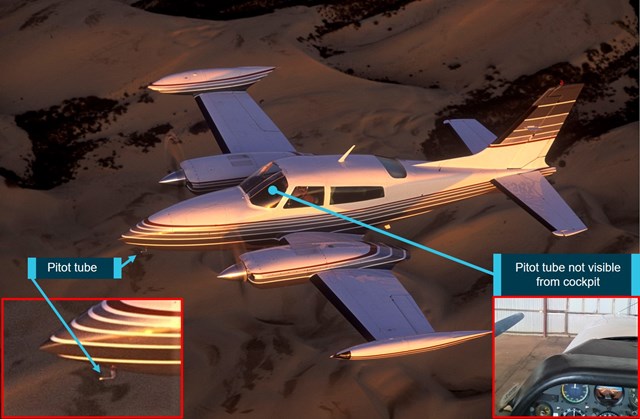| Occurrence Briefs are concise reports that detail the facts surrounding a transport safety occurrence, as received in the initial notification and any follow-up enquiries. They provide an opportunity to share safety messages in the absence of an investigation. |
What happened
On 17 June 2020, the pilot of a Cessna 310 commenced the first flight of the day from runway 11 at Darwin, Northern Territory. This was a planned charter flight with one pilot and four passengers on board. As the aircraft accelerated down the runway, the pilot observed an indicated airspeed of 40 kt, and with the understanding the airspeed was live,[1] attention was turned to engine readings and maintaining directional control for the remainder of the take-off run.
Shortly after becoming airborne, the pilot checked the airspeed and noticed that the indicated airspeed was now zero. A rejected take-off was not possible with the height already achieved and the length of runway remaining, so the pilot contacted air traffic control and conducted a return to land.
Upon exiting the aircraft, the pilot discovered the cover had been left on the pitot tube[2] (Figure 1). The operator assessed that the indication early in the take-off was likely due to fluctuations in pressure as the aircraft accelerated. The pitot cover was removed and the flight proceeded without further incident.
Operator comment
The aircraft operator has advised the ATSB that they have conducted a debrief with the pilot that included the pilot’s obligation to conduct a final walk-around prior to engine start.
Figure 1: Pitot tube cover

Source: Operator.
Figure 2: Cessna 310 pitot tube location

Source: Stock photo; inset photo provided by operator. Annotated by the ATSB.
Safety message
This incident highlights the importance of ensuring that all pre-flight checks and procedures are carried out systematically as detailed in the flight manual.
It also serves as a reminder to remain vigilant with monitoring and checking aircraft performance, in particular during the critical phases of flight. Indicated airspeed is the primary means of determining whether an aircraft will have sufficient performance available to climb away, or if the pilot’s best course of action is to reject the take-off.
About this report
Decisions regarding whether to conduct an investigation, and the scope of an investigation, are based on many factors, including the level of safety benefit likely to be obtained from an investigation. For this occurrence, no investigation has been conducted and the ATSB did not verify the accuracy of the information. A brief description has been written using information supplied in the notification and any follow-up information in order to produce a short summary report, and allow for greater industry awareness of potential safety issues and possible safety actions.
__________


